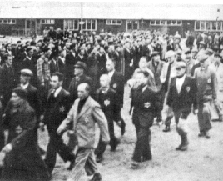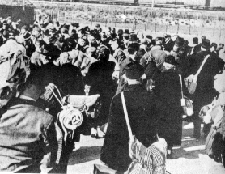Westerbork (Holland)

A transfert from Westerbock

A transfert from Westerbock
The camp of Westerbork was situated about 15 km from the village of Westerbork. This camp had been opened by the Dutch authorities during the summer 1939 in order to receive the Jewish refugees coming from Germany. The first refugees arrived in Westerbork on October 9th, 1939. When the German army invaded Holland, there were 750 refugees in the camp.
On July 1st, 1942, the German authorities took control of the camp. Westerbork became officially a "transit camp" (Durchgangslager Westerbork). On July 14th, 1942, all the Jews were examined by the SS in order to determine who was able to work or not. The first train arrived on July 15th and left the camp on July 16th with 1,135 of the first selected Jews. By the end of the month, nearly 6,000 Dutch Jews had, in fact reached Auschwitz, where the majority were gassed. The destination of this train (and all the following trains) was Auschwitz. In the beginning, the transfers were done at the station of Hooghalen. In November 1942, and after new rail lines had been constructed, the trains arrived directly into the camp. More than 103.000 Jews were transferred from Westerbork to Auschwitz or Sobibor (an extermination camp in Poland).
The camp of Westerbork was a very strange place. There was a school ( only for the "orphans", i.e. those children who came without their parents), a hair-dresser, an orchestra and even a restaurant. If a prisoner had enough money, it was possible for him to buy goods that were impossible to find elsewhere in Holland at this time. This "comfort" was designed by the SS in order to avoid any problem during the transfers to Auschwitz. A lot of prisoners thought that the condition of life would be the same in the camps of Poland. The Nazis seemed to always leave just a little hope for survival.
The most tragic part of the story of this camp is that the SS had very little to do with the transfers: the selections were made by a Jewish security service. The Nazi commandant gave the orders; the Jewish "governing" body only carried them out, in fear of themselves being deported. Imagine the irony, Jews selecting other Jews for certain death. The transfers were often done under the control of Dutch policemen. There was a transport to the extermination camps every Tuesday. Before Tuesday, the camp was in panic. Every prisoner feared selection for the next transport. On Tuesday evenings, those who were not selected had just one more week of rest before thenext selection.
The transports stopped in September 1944. When the Allies liberated Westerbork, 900 prisoners remained in the camp. The camp has been totally destroyed after the liberation. Nothing remains of the camp. However, there is a very poignant monument and a very interesting and well documented memorial center at the site. The monument consists of a piece of railroad track, which at its end is twisted and points into the sky.

Their last destination: the extermination camps...